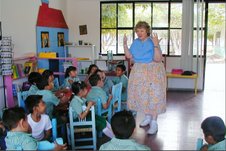El Dia de Los Muertos is one of Mexico's most traditional holidays. Celebrated on November 1st and 2nd, the holiday stems from Indian celebrations combined with the Spanish Christian celebration of All Saints and All Souls Days in the church. Churches in the USA celebrate All Saints and All Souls Day but not to the extent that it is celebrated in Mexico.
In this post and in the next few posts, I will try to explain a little about the tradition and show you some photos I took here in Puerto Vallarta on Nov. 1st.
The celebration is an opportunity for families to gather and remember those who have died. Tradition says that on one day of the year, the souls of those who have passed will return to earth and must be welcomed by the family. Nov. 1 is the day of the "angelitos" (the children) who have died and Nov. 2 is the day to remember the adults who have passed away.
Families make an altar, called an ofrenda, or an offering, in their home and dedicate it to a loved one who is dead. On the night of Nov. 2, the family gathers at the family burial plot in the cemetery for a family reunion and to celebrate the life of the one they are honoring. They prepare special foods, have a picnic, beer, tequila or soft drinks, sometimes have mariachias who play music for sing-a-longs, and often fireworks are part of the celebration.
On the days previous to Nov. 2, the family cleans the area of the cemetery and spruces up the grave site, and then decorates it with wreaths, flowers, candles, streamers and many marigolds, which are considered the "flower for the dead". Just as poinsettias are thought of in the USA as our "Christmas flower", the marigold is thought of as the "flower for El Dia de los Muertos" in Mexico, so you will see many, many marigolds in the displays.
Altars in the homes are prepared in a certain way. There are usually 7 steps, or levels, to the altar, although most families now may not have 7 levels but the important thing is to have a few levels to your altar. On the altars are 4 elements: earth, wind, water and fire and each is represented in some way by objects put on the altar.
Earth represents crops. The souls are fed by the aroma of food so you will find food on an altar. Wind is represented by a moving object, usually tissue paper which is intricately cut and is called papel picado. Water is to quench the thirst of the soul after his long journey back and there will be water, atole (a corn drink), or if the person liked a stronger beverage (!) there will be beer or tequila on the altar. Fire is remembered by using candles.
Some of the typical items found on an altar include incense, called copal. This is a special incense from a tree and it is supposed to help the soul find his way back to earth. Skeletons are everywhere. The most well known skeleton is called La Catrina and she is a fancy lady skeleton made famous by a Mexican artist many, many years ago. You will find skulls made of sugar (las calaveras) and the name of the person remembered will be on the skull. Skeletons are dressed up in many, many different ways as you will see in the pictures.
Candles and votive lights, marigolds and other flowers, and pan de muerto, which is a sweet bread made especially for the festival. The bread is round and has a knob of dough representing the head and bones in a criss-cross pattern on top of the bread. There is usually a photograph of the person being remembered on the altar, and also the favorite foods and beverages of that person. There may be meat or chicken in mole sauce, rice, frijoles and if it is a child, there will be toys and sweets of some kind.
I hope you enjoy looking at the altars in the following blogs and learn that the "Day of the Dead" is not a grim, morbid holiday, but one of happiness in remembering loved ones who have passed away.
Hasta luego.
Friday, November 9, 2007
Subscribe to:
Post Comments (Atom)

1 comment:
Are the sugar skulls consumed after the two days or are they simply for decoration?
This is all so fascinating!
Post a Comment